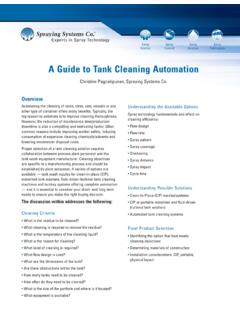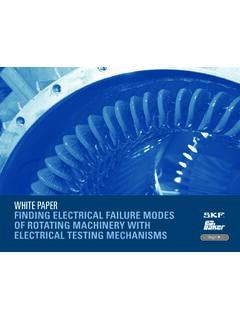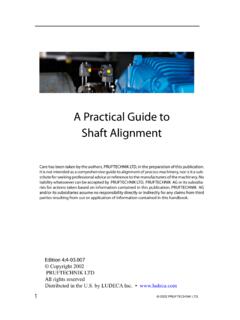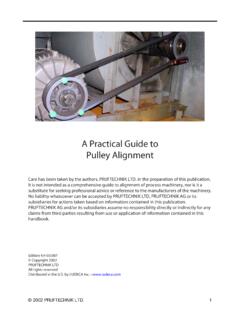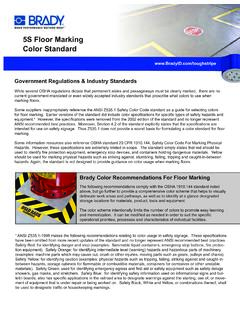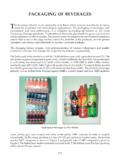Transcription of Proper Dyne Testing - Plant Services
1 Proper Dyne Testing : How, Why, and When To Perform An Overview of Dyne Testing Methods, Surface Tension Measurement, and Corona Treating 1229 W. Cortland St. Chicago IL, 60614-4805 USA. 800-621-1296 773-248-0099. FAX: 800-99 FAXUV 773-880-6647. Copyright 2005 UV Process Supply, Inc. Proper Dyne Testing : How, Why, and When To Perform Table of Contents Introduction ..1. Dyne Testing Options ..1. Suggested Treat Levels ..4. Dyne Testing Procedure ..6. Contact Angle Measurement ..8. Polymer Surface Treatment ..10. Surface Treatment for 3-D Objects ..11. Surface Tension Selection Guide ..13. Copyright 2005 UV Process Supply 1229 W.
2 Cortland St., Chicago, IL 60614. email: 773-248-0099 FAX 773-880-6647. INTRODUCTION. The ability of a substrate to adhere inks, coatings, or adhesives is directly related to its surface energy. If the substrate surface energy does not significantly exceed the surface tension of the fluid which is to cover it, wetting will be impeded and a poor bond will result. In a dyne test, wetting tension liquids are spread over a film surface to determine printability, coating laydown, and heat sealability of treated films. Solutions of increasing wetting tensions are applied to the polymer film until a solution is found that just wets the polymer surface.
3 The term "surface energy," or wetting, is normally used to describe the reactivity of the surface of a solid substrate, while "surface tension" is used in reference to a liquid. Frequently, the two terms are used interchangeably, since both refer to the same force at which molecules at the surface of the substrate ultimately cling to one another. The phenomenon of surface energy is based on the relative energies of the solid substrate and the liquid in contact with it. For converters of plastic films , knowing the surface energy of a polymer surface is critical in assuring good coating and print quality, as well as the adhesion of laminated films - particularly with the growing popularity of water-based inks, coatings, and adhesives.
4 The surface energy of a solid polymer cannot be measured directly because solids typically show no reaction to the exertion of surface energy. Consequently, practical measurements of surface energy involve the interaction of the solid with a test liquid to determine wetting tension as a measure of surface energy. The surface energy of a film should be between 3 dynes/cm and 10 dynes/cm greater than the surface tension of the ink in order to ensure acceptable performance. Thus, even pretreated films should be checked before use to make sure Proper dyne energy is present. Surface tension is expressed in units of force per unit of width, similar to web tension.
5 However, since surface tension forces are so much smaller, it is more convenient to express them in dynes per centimeter, rather than pounds per inch. Hence, the act of measuring surface energy, or tension, is typically known as a "dyne test.". DYNE Testing OPTIONS. Cotton-swab applicators (part #N001-007), solution-tipped "dyne pens" (part #N001-002), or full-etch drawdown rods (part #N008-005) are typically used to smoothly apply wetting solutions across polymer surfaces. The generally accepted solution to verify dyne levels or surface energy is a mixture of Ethyl Cellosolve and Formamide. This solution contains a dye to make it easier to see.
6 When using these wetting tension solutions, all safety precautions as listed on the labels should be observed, as there are specific hazards associated with using them. These solutions also have an average shelf life of only six months, so they should be properly dated at time of use and replaced when the expiration date has been reached. If this isn't done, false dyne information could result, along with a rejection of printed material by the customer. UV Process Supply 1229 W. Cortland St., Chicago, IL 60614 Page 1 Copyright 2005. 773-248-0099 FAX 773-880-6647 email: The three methods that are generally used to check the surface energy of a substrate (cotton-swab applicators, dyne-pens, and drawdown rods) are detailed here: Cotton Swab Applicator method: Dyne solutions of various levels (part #N001-011) are placed on the substrate until a solution is found that only wets the surface of the film .
7 The tip of the applicator (part #N001-007) is dipped in the test solution from a calibrated dyne-level solution stock container. The solution is spread lightly over approximately one square inch of the test material. A. minimum amount of solution should be used because an excess can distort readings. If the wetting solution stays intact (doesn't break into droplets) for two seconds, the treat level is at least as high as the dyne level recorded on the bottle of solution. Repeat the procedure until a solution is used that beads up on the surface of the material being tested. The film treat level would then be identified as the last solution tested that remains wetted out on the surface.
8 A clean cotton applicator must be used for each test repeated to avoid contamination of the different solutions and possible distortion of results. Do not repeat the test in the same area of the film . This method has been a standard for years but is still somewhat subjective and inconsistent because of the personnel involved in the application of the fluid to the substrate. This procedure should be done in a lab environment because there is always a risk of spilling the contents of the bottles or leaving the used swabs lying around that could lead to skin contact. The greatest advantage of the cotton swab applicator method is its speed and simplicity.
9 For example, it can be used on the converting room floor to easily identify problems with corona treaters. Though it provides an established procedure for determining surface tension, this method presents several challenges for reliability and consistency of results: Care must be taken to limit evaporation of solutions, since it changes concentrations and, consequently, changes dyne level values. One problem may be that lab personnel using cotton swabs have a tendency to vary the amount that is picked up by the cotton swab, thus varying the results of the test. Also, the method of rubbing the liquid onto the polyolefin surface with a cotton-tipped applicator varies from person to person.
10 This rubbing also tends to give erratic dyne level results. Dyne-pen method: This is a press-side method that is usually used by the operator to check the treat level of a substrate just prior to print. Pens with built-in applicators (part #N001-002, #N001-001, or #N001-010) are pulled across the entire web in a straight line. The pens have their dyne level listed on them. As the pen is drawn across the web, the operator looks to see that the solid line does not break for two seconds. This method is not highly accurate because of possible contamination of the tip by multiple uses. The advantages are that it is a quick method, shows the operator which side is treated, and checks for the condition known as back-treat.

